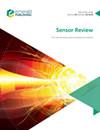设计定制阻力传感器,优化传感鞋垫
IF 1.4
4区 工程技术
Q3 INSTRUMENTS & INSTRUMENTATION
引用次数: 0
摘要
目的目前,已经发表了几项研究,使用传感鞋垫通过足底压力来估计地面反作用力。然而,有关开发鞋垫的设计参数、制造技术和指南的信息很少,经常留下不允许复制鞋垫的空白。本研究旨在实证研究构建用于人类步态的传感鞋垫的主要参数。设计/方法/方法建造了两个装置来评估力传感器。第一个重点是具有不同设置的传感器的结构:传感器导电迹线的密度(迹线的厚度和距离)和传感器的惯性(使用垫片以防止不必要的读数)。第二个设备专注于数据采集和处理系统:模数转换器的分辨率、采集速率和传感器激活水平。发现模数转换器的分辨率和采集速率的增加不会导致噪声增加。减少传感器的覆盖面积可以增加鞋垫的传感能力。在不改变电路和采集系统的情况下,可以使用垫片来调整传感器的惯性。独创性/价值大多数传感鞋垫都使用商用传感器。因此,不可能进行完全的定制。本文绘制了制造定制传感器和数据采集系统的主要变量。这项工作还提供了一个案例研究,其中可以看到传感鞋垫和带力平台的器械跑步机之间的相关性中参数的影响。本文章由计算机程序翻译,如有差异,请以英文原文为准。
Design a custom resistive force sensors to optimize sensorized insoles
Purpose
Currently, several studies have been published using sensorized insoles for estimating ground reaction force using plantar pressure. However, information on design parameters, manufacturing techniques and guidelines for developing insoles is scarce, often leaving gaps that do not allow reproducing the insole. This study aims to empirically investigate the main parameters of constructing a sensorized insole for application in human gait.
Design/methodology/approach
Two devices were built to evaluate the force sensors. The first focuses on the construction of the sensors with different settings: the density of the sensor’s conductive trails (thickness and distance of the trails) and the inertia of the sensors (use of spacers to prevent unwanted readings). The second device focuses on the data capture and processing system: resolution of the analog–digital converter, acquisition rate and sensor activation level.
Findings
The resolution increase of the analog–digital converter and acquisition rate do not contribute to noise increase. Reducing the sensors’ coverage area can increase sensorized insole capacity. The inertia of the sensors can be adjusted using spacers without changing the electrical circuit and acquisition system.
Originality/value
Most sensorized insoles use commercial sensors. For this reason, it is not possible a full customization. This paper maps the main variables to manufacture custom sensors and data acquisition systems. This work also presents a case study where it is possible to see the influence of the parameters in the correlation between the sensorized insole and an instrumented treadmill with a force platform.
求助全文
通过发布文献求助,成功后即可免费获取论文全文。
去求助
来源期刊

Sensor Review
工程技术-仪器仪表
CiteScore
3.40
自引率
6.20%
发文量
50
审稿时长
3.7 months
期刊介绍:
Sensor Review publishes peer reviewed state-of-the-art articles and specially commissioned technology reviews. Each issue of this multidisciplinary journal includes high quality original content covering all aspects of sensors and their applications, and reflecting the most interesting and strategically important research and development activities from around the world. Because of this, readers can stay at the very forefront of high technology sensor developments.
Emphasis is placed on detailed independent regular and review articles identifying the full range of sensors currently available for specific applications, as well as highlighting those areas of technology showing great potential for the future. The journal encourages authors to consider the practical and social implications of their articles.
All articles undergo a rigorous double-blind peer review process which involves an initial assessment of suitability of an article for the journal followed by sending it to, at least two reviewers in the field if deemed suitable.
Sensor Review’s coverage includes, but is not restricted to:
Mechanical sensors – position, displacement, proximity, velocity, acceleration, vibration, force, torque, pressure, and flow sensors
Electric and magnetic sensors – resistance, inductive, capacitive, piezoelectric, eddy-current, electromagnetic, photoelectric, and thermoelectric sensors
Temperature sensors, infrared sensors, humidity sensors
Optical, electro-optical and fibre-optic sensors and systems, photonic sensors
Biosensors, wearable and implantable sensors and systems, immunosensors
Gas and chemical sensors and systems, polymer sensors
Acoustic and ultrasonic sensors
Haptic sensors and devices
Smart and intelligent sensors and systems
Nanosensors, NEMS, MEMS, and BioMEMS
Quantum sensors
Sensor systems: sensor data fusion, signals, processing and interfacing, signal conditioning.
 求助内容:
求助内容: 应助结果提醒方式:
应助结果提醒方式:


